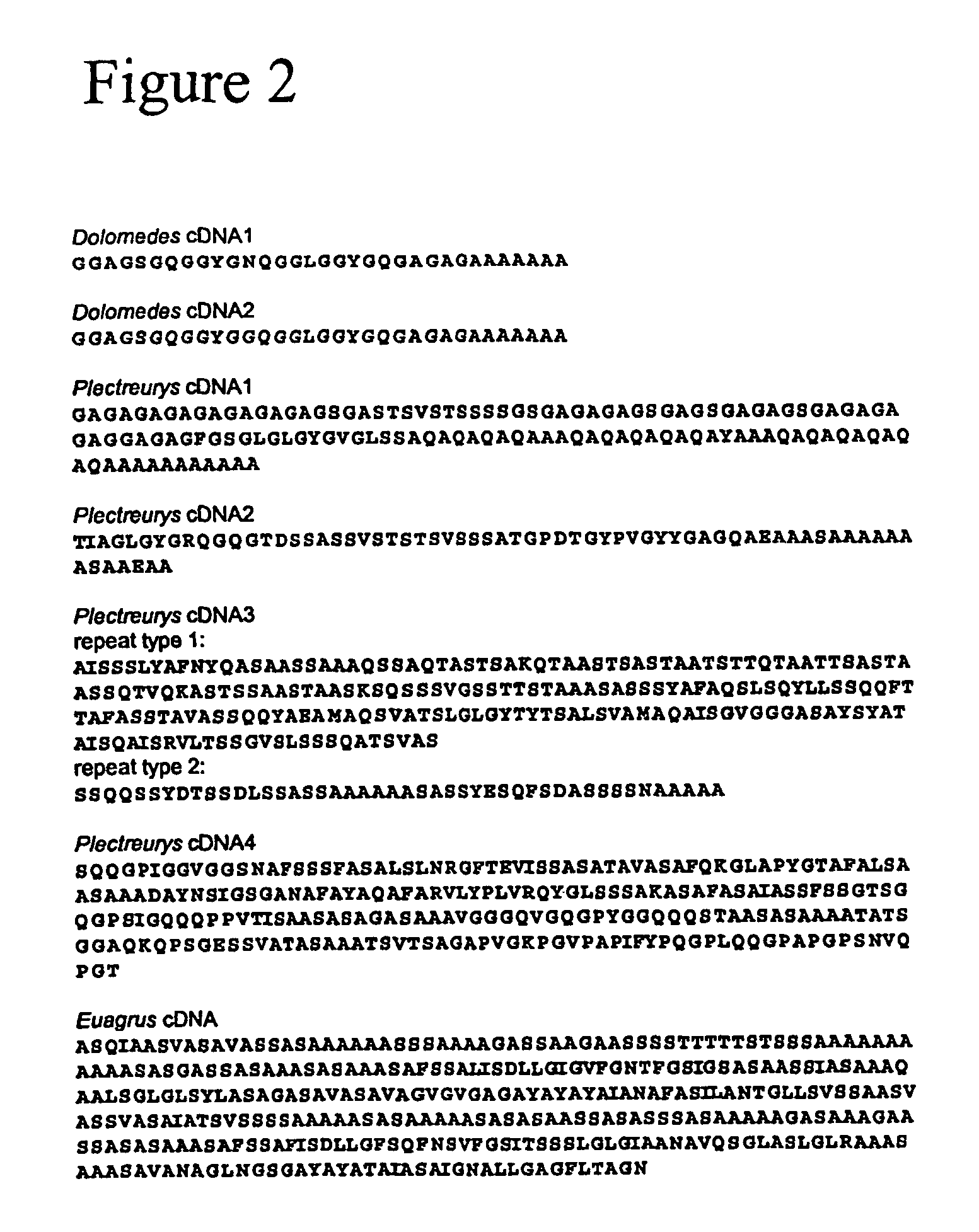Spider silk protein encoding nucleic acids, polypeptides, antibodies and methods of use thereof
a technology of nucleic acids and spider silk, applied in the field of molecular and cellular biology, to achieve the effect of high tensile strength
- Summary
- Abstract
- Description
- Claims
- Application Information
AI Technical Summary
Benefits of technology
Problems solved by technology
Method used
Image
Examples
example i
Identification of Clones Encoding Spider Silk Proteins
[0127]In order to identify novel spider silk proteins and expand the limited database of nucleic acid sequences encoding fibroin proteins, eleven cDNA libraries derived from silk glands of seven spider genera were generated. cDNA data were supplemented by information from two genomic libraries and PCR-amplified sequences (7). Partial cDNA or gene sequences for 28 fibroins from seven families of Araneae were identified. The data, as described herein, greatly extend the phylogenetic diversity of characterized fibroins (FIG. 1).
Methods for Collection of Sequence Data
[0128]cDNA libraries were made from major ampullate glands of Argiope trifasciata (Araneidae) and Lactrodectus geometricus (Theridiidae), flagelliform glands of A. trifasciata, ampullate glands of Dolomedes tenebrosus (Pisauridae), two sets of silk glands from Plectreurys tristis (Plectreuridae), and silk glands of the mygalomorph Euagrus chisoseus (Dipluridae). Glands f...
example ii
Clones of MaSp1- and Masp2-Like Spider Silk Proteins
[0139]For the purposes of further classification and structure / function analyses of the novel spider silk proteins of the present invention, fibroin sequences were allocated to different ortholog groups of Nephila clavipes. Silk fibroins are long proteins, comprised largely (>90%) of ensemble repeat units which are internally repetitive (4, 5, 8, 9). Ensemble repeat units from different fibroins vary in length, sometimes by an order of magnitude. It is difficult to make residue-to-residue homology statements between molecules because of this length variation and the overall modular structure of silk proteins. The gross similarities and differences between ensemble repeat units were, therefore, initially used to sort araneoid fibroins into four classes. The following proteins correspond to the MaSp1-like type of fibroin previously described in N. clavipes (5, 9).
[0140]MaSp1-like group proteins were characterized by short ensemble re...
example iii
Clones of Flagelliform-Like Spider Silk Proteins
[0142]Based on the gross similarities and differences between ensemble repeat units, the following group of proteins was classified as flag-like type fibroins, similar to those previously described in N. clavipes (5, 9).
[0143]Flag-like group proteins were characterized by long ensemble repeats comprised mainly of clustered GGX and GPG(X)n motifs. Each ensemble repeat had a single “spacer” region that contained amino acids atypical of araneoid silks (5). The flag-like group of spider silk proteins includes Flag from N. clavipes and two proteins encoded by A. trifasciata Flag cDNA clones (SEQ ID Nos: 17-18). Amino acid sequences encoded by SEQ ID NOs: 17-18 are provided in SEQ ID NOs: 45-46, respectively.
PUM
| Property | Measurement | Unit |
|---|---|---|
| tensile strength | aaaaa | aaaaa |
| Tm | aaaaa | aaaaa |
| Tm | aaaaa | aaaaa |
Abstract
Description
Claims
Application Information
 Login to View More
Login to View More - R&D
- Intellectual Property
- Life Sciences
- Materials
- Tech Scout
- Unparalleled Data Quality
- Higher Quality Content
- 60% Fewer Hallucinations
Browse by: Latest US Patents, China's latest patents, Technical Efficacy Thesaurus, Application Domain, Technology Topic, Popular Technical Reports.
© 2025 PatSnap. All rights reserved.Legal|Privacy policy|Modern Slavery Act Transparency Statement|Sitemap|About US| Contact US: help@patsnap.com



